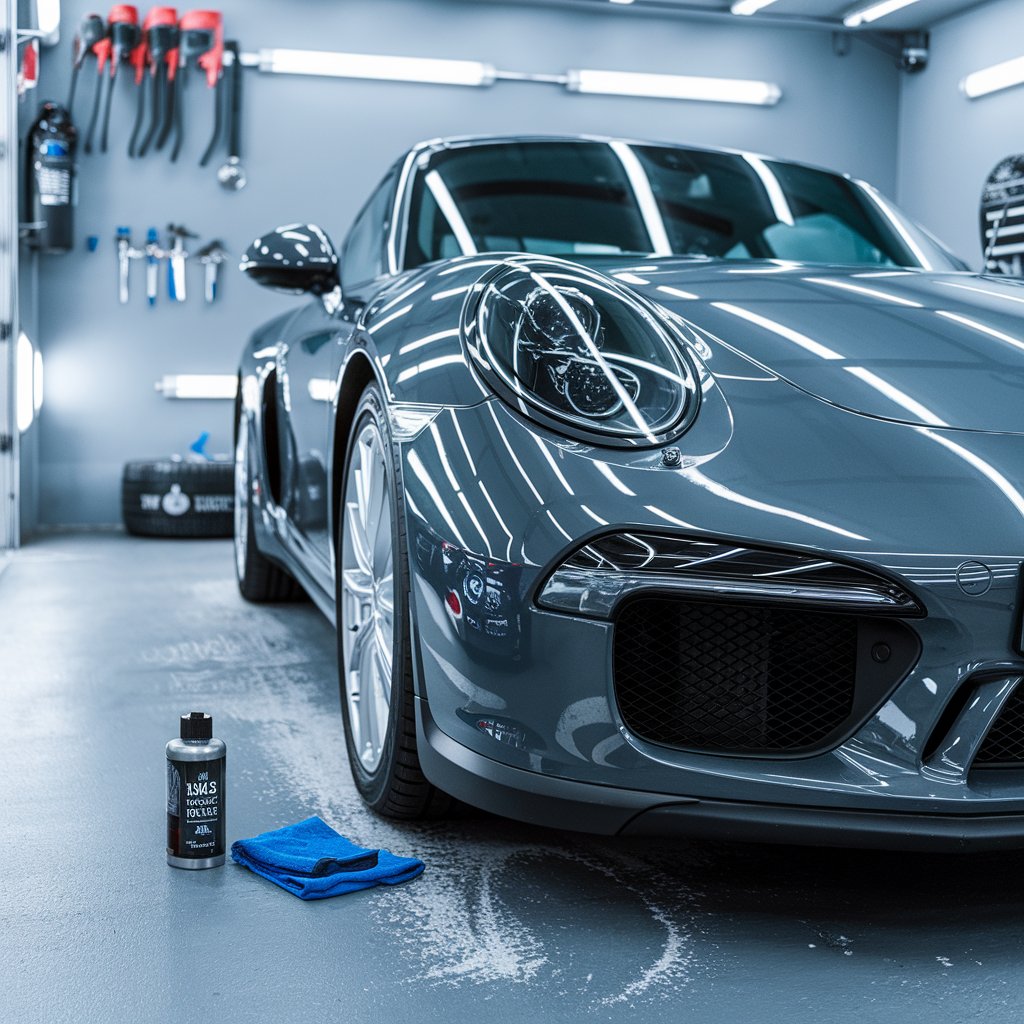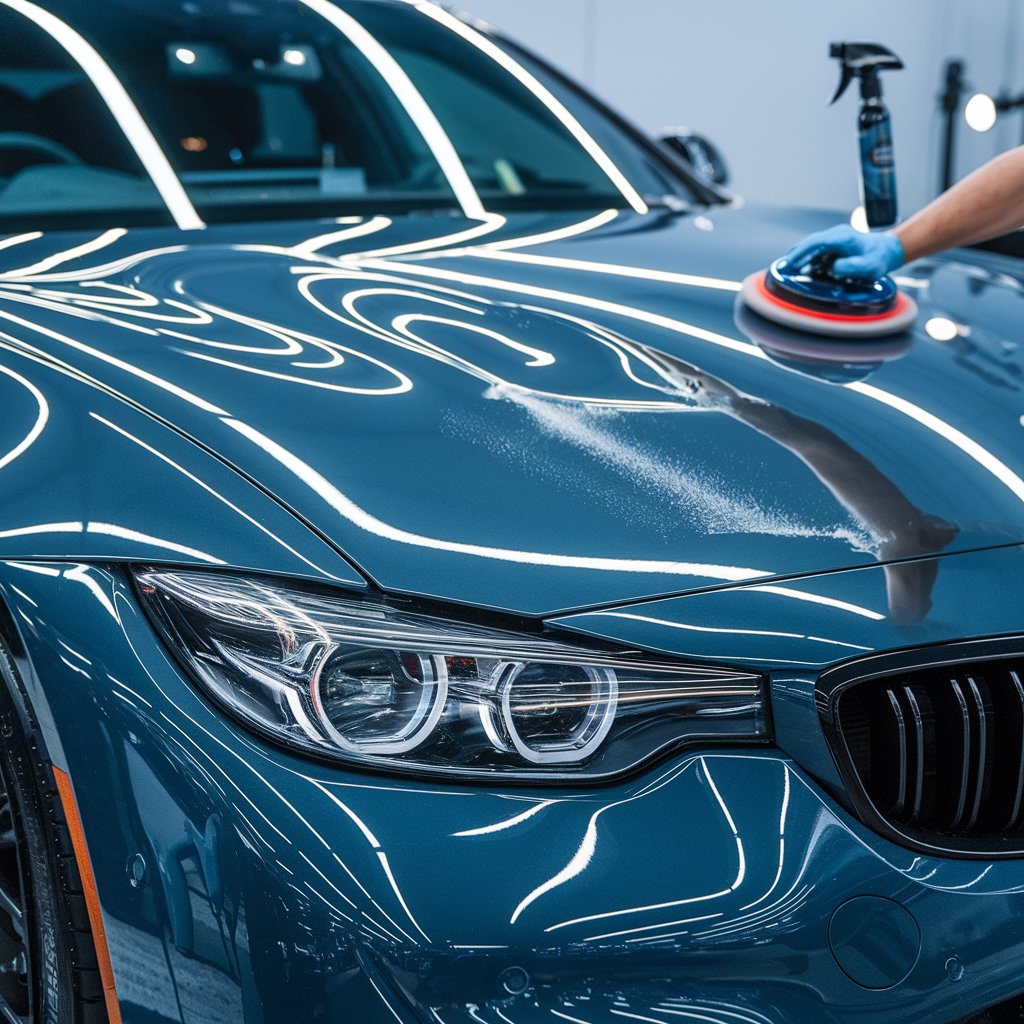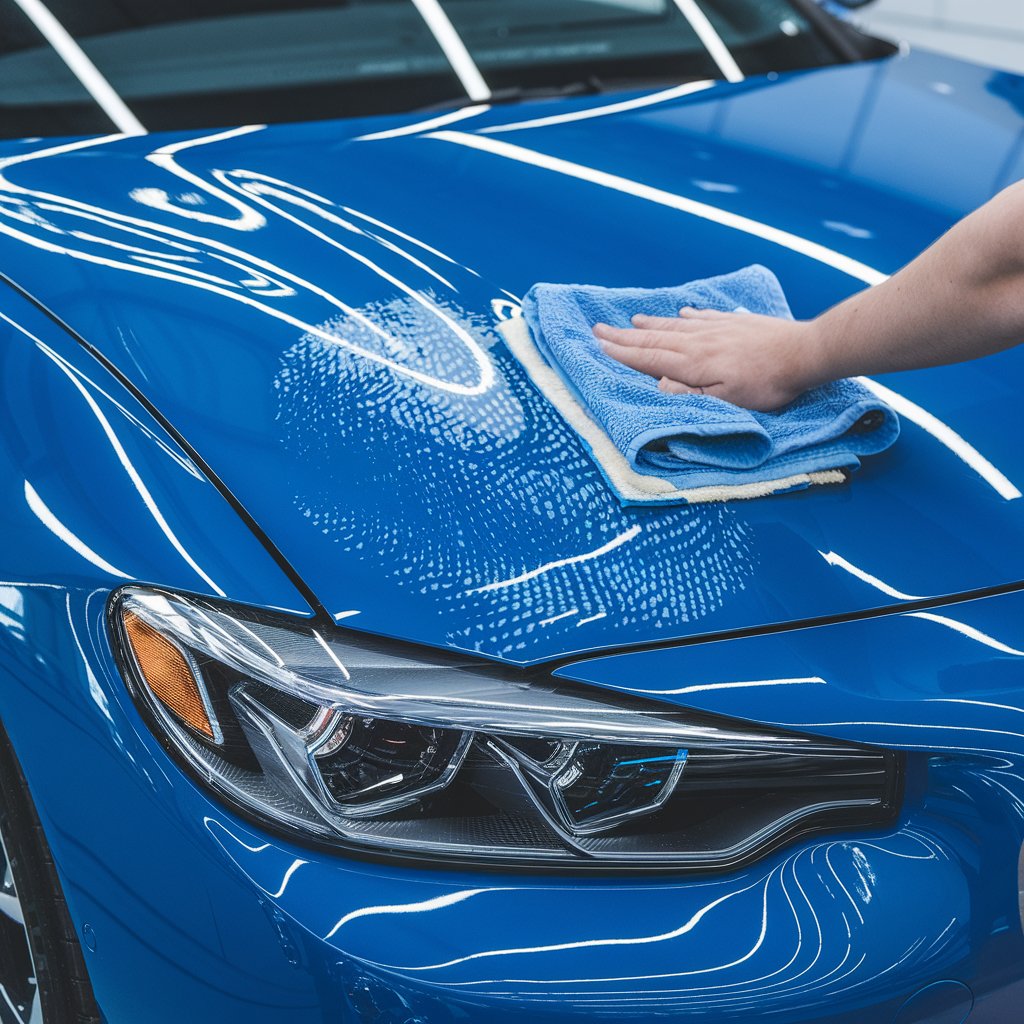Applying wax over a protective ceramic film for cars is possible and can enhance protection if done correctly. It’s important to confirm compatibility between the wax and the ceramic surface. A thorough cleaning is essential before using a microfiber applicator to apply the wax in small sections. While wax provides an extra protective layer and enhances gloss, improper application can reduce the hydrophobic performance of the ceramic coating. Understanding the ideal waxing technique and proper maintenance practices ensures long-lasting care for the vehicle’s protective finish.
Key Takeaways
- Wax can be applied over ceramic coatings if it’s compatible, avoiding any damage to the coating.
- Ensure the vehicle’s surface is thoroughly clean before applying wax to prevent interference with the coating.
- Waxing is not necessary for ceramic coatings, but it can provide additional protection and shine.
- Incorrect wax application may reduce the hydrophobic properties and effectiveness of the ceramic coating.
- Use wax sparingly and ensure proper application to avoid residue buildup and diminished coating performance.
What is a Ceramic Coat and How Does It Work?
A ceramic coat is a liquid polymer applied to a vehicle’s exterior that chemically bonds with the factory paint, providing a protective layer.
This coating offers numerous benefits, such as enhanced resistance to contaminants, UV rays, and minor scratches, while maintaining a glossy finish.
Despite its advantages, there are common misconceptions, including the belief that it renders vehicles completely impervious to damage and eliminates the need for maintenance.
Understanding Ceramic Coatings
Ceramic coatings, though often misunderstood, serve as a highly protective layer for a vehicle’s paintwork—a ceramic-coated car benefits from a ceramic layer that acts as a durable shield against environmental contaminants.
This protective coating is formulated with advanced polymers that enhance the hydrophobic properties of the ceramic, ensuring water and dirt are effectively repelled. The coatings are designed to repel harmful UV rays, chemicals, and minor abrasions, thereby preserving the vehicle’s aesthetic appeal.
Ceramic coatings provide a seamless, glossy finish that enhances the paint’s depth and clarity. By creating a robust barrier, the effectiveness of the ceramic is maintained over time, reducing the need for frequent washes and detailing.
Proper maintenance is essential to maintain a ceramic coating’s longevity and performance.

Benefits of Ceramic Coating for Car Owners
When considering protective options for vehicle exteriors, a ceramic coat stands out due to its advanced technology and multifaceted benefits. Ceramic coating offers car owners a durable solution to protect the surface of their car against UV rays, contaminants, and minor scratches. Unlike traditional car wax, a ceramic coated vehicle requires less frequent maintenance and enhances the vehicle’s gloss. Once the coating is applied to your car, maintaining ceramic protection becomes an integral part of car care. The ceramic layer acts as a sacrificial barrier, preserving the paintwork beneath.
| Feature | Benefit |
|---|---|
| UV Protection | Shields paint from sun damage |
| Hydrophobic Properties | Repels water and dirt |
| Enhanced Gloss | Increases vehicle shine |
| Durability | Long-lasting compared to wax |
| Scratch Resistance | Minimizes minor abrasions |
Common Misconceptions About Nano Ceramic Coating
Despite its growing popularity, car enthusiasts and owners alike often misunderstand nano ceramic coating. Many believe that waxing a ceramic-coated car is necessary for maintenance.
However, ceramic coatings are designed to provide long-term protection, rendering traditional wax redundant. Wax over ceramic can interfere with the hydrophobic properties of the ceramic coating, potentially diminishing its performance.
A ceramic-coated vehicle benefits from enhanced durability and UV resistance, which traditional wax cannot match. The properties of the ceramic coating form a protective layer that reduces the need for frequent waxing. For a deeper understanding of how ceramic coatings compare to nano coatings, check out this guide on ceramic vs. nano coating.
Protecting your ceramic coating involves proper washing and occasional inspections rather than applying wax. Understanding ceramic coating maintenance guarantees the longevity and effectiveness of this advanced protective solution.
How to Apply Wax on Ceramic Coatings Properly
To apply wax over a ceramic coating effectively, it is vital to select wax products specifically designed to complement ceramic surfaces.
Following a step-by-step guide guarantees the wax is applied evenly and adheres properly, enhancing the vehicle’s protection and gloss.
Avoiding common mistakes, such as over-application or using incompatible products, is essential to maintaining the integrity of the ceramic coating.
Choosing the Right Wax Products
Selecting the appropriate wax products for use over ceramic coatings necessitates a careful understanding of compatibility and desired outcomes.
When choosing to apply wax over ceramic coatings, one must consider whether to utilize paste wax or liquid wax formulations. Carnauba wax, renowned for its deep gloss, serves as an excellent choice for those seeking additional shine in car wax applications.
However, evaluating the best wax products includes determining the ease of application and longevity. Paste wax often provides a durable finish, while liquid wax offers convenience.
It’s essential to select waxes specifically designed to enhance, not diminish, the properties of the ceramic coating. Properly applied, these additional wax layers can contribute to enhanced aesthetics without compromising the integrity of the ceramic surface.
Step-by-Step Guide to Waxing a Ceramic-Coated Car
Understanding the compatibility of wax products with ceramic coatings is the first step toward achieving ideal results.
Before applying wax on ceramic coatings, make certain the vehicle’s surface is thoroughly clean. Begin with a detailed car wash to eliminate dirt and contaminants.
Ceramic coatings offer a durable shield, but waxing your ceramic-coated car adds an extra protective layer. Select a wax that is easy to apply and specifically designed for use over ceramic coatings.
Once the car is dry, apply wax on top of the coating using a microfiber applicator. Distribute the wax evenly across the surface, working in small sections.
Allow the wax to cure as per product instructions before buffing to achieve a glossy finish. This detailing routine enhances and preserves the coating’s benefits.
Common Mistakes to Avoid When Applying Wax on Ceramic
When applying wax on ceramic coatings, it is vital to avoid common mistakes that can undermine the protective benefits.
Coatings are known for their durability, but improper waxing can diminish their effectiveness. Here are key points to reflect upon:
- Avoid using abrasive products: Always select a non-abrasive car wax on top of the ceramic coated vehicle to prevent surface scratches.
- Don’t apply wax over a ceramic when wet: Verify the surface is completely dry before applying wax on top to guarantee proper adherence and finish.
- Neglecting proper detailing steps: Thoroughly clean the surface before waxing to remove contaminants that may interfere with the bonding of wax and ceramic.
Wax can add an extra layer of shine, but careful application over a ceramic coating is vital.
Is It Safe to Apply Wax on Ceramic Coatings?
When considering the application of wax over ceramic coatings, it is essential to evaluate potential risks such as reduced hydrophobic properties and compromised durability.
Traditional car wax can interfere with the self-cleaning capabilities of the ceramic surface, potentially leading to water spots and diminished gloss.
Additionally, carnauba wax, while generally safe, may not bond effectively with ceramic coatings, leading to uneven application and reduced protective benefits.
Potential Risks of Waxing a Ceramic-Coated Car
Applying wax over a ceramic-coated car introduces potential risks that can compromise the coating’s performance and longevity.
While a ceramic coating provides a robust shield against environmental factors, adding wax to a ceramic coating can potentially interfere with its inherent properties.
When applied over a ceramic coating, wax can help enhance shine but may also mask the hydrophobic effects, reducing the vehicle’s self-cleaning abilities.
Additionally, applying the wax incorrectly could lead to streaks or residue buildup, which can deteriorate the ceramic coated vehicle over time.
- Altered Hydrophobic Properties: Waxing may reduce the hydrophobic effect of the ceramic coating.
- Residue Accumulation: Incorrect application can cause wax residues to build up.
- Potential Layer Conflicts: Incompatibility between ceramic coatings and wax may undermine the original coat’s effectiveness.
Effects of Traditional Car Wax on Ceramic Coatings
Although ceramic coatings provide a durable protective layer for vehicles, the application of traditional car wax over these coatings can introduce variables that affect their performance.
When wax is applied to a car’s ceramic coating, it may temporarily enhance gloss, giving the car a polished appearance. However, the use of wax on top of ceramic coatings can diminish the hydrophobic properties the coating provides, potentially reducing its effectiveness.
A car with a ceramic coating is designed to repel water, dirt, and contaminants efficiently, and traditional wax may alter this behavior. While wax can keep a car looking shiny, it is essential to assess whether the benefits of applying wax to a ceramic surface outweigh the potential reduction in coating performance.
Can Carnauba Wax Damage a Ceramic Coat?
The interaction between carnauba wax and ceramic coatings raises questions about compatibility and safety.
Ceramic coatings are known for their durability and hydrophobic properties, and they are designed to make your car look pristine while protecting the paint.
However, applying carnauba wax on top of a ceramic coating can alter these properties.
While carnauba wax does not inherently damage the ceramic coat, it can reduce the coating’s effectiveness by creating a layer that inhibits its natural sheen and hydrophobic qualities.
- The application of wax may lead to reduced hydrophobic performance.
- Carnauba wax can obscure the glossy finish that ceramic coatings are known for.
- The durability of the coating lasts, but may not be fully optimized with wax application.
To enhance longevity, it’s generally advisable to avoid waxing your car with carnauba after coating.
Benefits of Wax Over Ceramic Coating
Applying wax over a ceramic coating can enhance a vehicle’s surface protection by adding a barrier against environmental contaminants.
This layer of wax also contributes to improved UV ray resistance, potentially extending the lifespan of the underlying ceramic coating.
Additionally, wax can augment the gloss and shine of the car’s exterior, providing a visually appealing finish.
Does Car Wax Enhance Protection
Car wax offers an additional protective layer over the existing ceramic coat. This top wax layer is designed to enhance the hydrophobic properties of the diy ceramic coating and spray coating.
By applying wax, owners can guarantee that dirt and contaminants are less likely to stick to a ceramic surface. This provides an added shield on nano coatings, complementing the fresh coating’s endurance.
- Enhanced Hydrophobicity: Wax improves the water-repelling properties of ceramic coatings.
- Contaminant Barrier: Provides an extra layer to prevent grime from adhering to the ceramic coat.
- Aesthetic Boost: Wax enhances gloss, augmenting the visual appeal of a ceramic-coated vehicle.
Does Waxing Improve UV Ray Resistance
While ceramic coatings are renowned for their strong protective properties against environmental factors, adding a layer of wax can further enhance a vehicle’s defense against UV rays. This extra detail layer can put an additional barrier against harmful solar radiation.
Coatings offer durability, but wax provides an added UV shield, especially beneficial for a ceramic coated vehicle every two years. Although ceramic coatings last forever in theory, they require maintenance. Applying wax can make your car’s surface more resistant to UV damage, ensuring longevity.
When used with products like car shampoo or ceramic coat SiO2 boost spray, waxing complements the protection. Compared to ceramic coatings alone, adding wax is a top car detailing method to fortify a vehicle’s exterior against UV effects.
How Wax on Top Affects Gloss and Shine
In addition to enhancing UV protection, wax applied over a ceramic coating greatly influences the vehicle’s gloss and shine. This combination can create a mirror-like finish that enhances the aesthetic appeal of the vehicle.
The additional layer of wax fills microscopic imperfections in the ceramic coating, resulting in a smoother surface that reflects light more evenly. Furthermore, wax augments the hydrophobic properties of the ceramic coat, leading to improved water beading and a cleaner appearance.
- Enhanced Reflectivity: Wax smooths the surface, boosting gloss.
- Improved Hydrophobicity: Water beads are more effective in reducing water spots.
- Increased Depth of Shine: Wax enhances the coating’s underlying depth, making colors appear richer.
These benefits collectively contribute to a more visually appealing and protected vehicle exterior.
Maintaining a Car with a Ceramic Coating
Proper maintenance of a car with ceramic coating involves adhering to regular car wash practices to preserve its protective properties. Utilizing a pH-neutral car shampoo is essential to prevent the degradation of the ceramic layer during cleaning. For a deeper understanding of why ceramic coating is crucial for long-term protection, refer toon ceramic coating for new cars. Reapplication of the ceramic coating and wax should be scheduled based on the manufacturer’s guidelines and the vehicle’s exposure to environmental elements.
Regular Car Wash Practices
Maintaining a vehicle with a ceramic coating demands adherence to specific car wash practices to preserve its protective properties and glossy finish. Regular cleaning is essential, but the methods employed must be gentle to avoid degrading the coating. High-pressure washes and harsh chemicals should be avoided. Instead, a two-bucket method is recommended to prevent swirl marks and scratches.
Additionally, microfiber towels are preferable due to their soft texture and efficient absorption.
Regular washing should be complemented by:
- Gentle Drying: Use a clean microfiber towel or air blower to prevent water spots without scratching.
- Avoiding Direct Sunlight: Wash the car in shaded areas to prevent water spots caused by rapid drying.
- Consistent Schedule: Maintain a routine cleaning schedule to prevent contaminants from bonding to the surface.
Using Car Shampoo Safely
Car shampoo plays a pivotal role in maintaining the integrity of a ceramic-coated vehicle. Selecting a pH-neutral shampoo is vital, as acidic or alkaline products can degrade the ceramic layer.
It is advisable to use a high-quality microfiber wash mitt to minimize abrasions on the ceramic surface. Additionally, a two-bucket wash method is recommended to reduce the risk of contaminants scratching the coating. One bucket should contain the shampoo solution, while the other holds clean water for rinsing the mitt. Regularly rinsing the mitt is essential to prevent dirt accumulation.
It is important to avoid automatic car washes with abrasive brushes, as they can compromise the coating. Proper rinsing and drying techniques, such as using a microfiber towel, further preserve the ceramic layer.
When to Reapply Ceramic and Wax
Preserving the longevity of a ceramic-coated vehicle involves not only careful cleaning practices but also the timely reapplication of the ceramic coating and wax.
The ceramic coating typically requires reapplication every 2-3 years, depending on the product quality and driving conditions. Conversely, wax needs more frequent attention, usually every 3-6 months, to maintain its protective properties and enhance gloss.
Monitoring the condition of the coating and wax is essential to guarantee peak performance.
- Ceramic Coating: Every 2-3 years to maintain durability and hydrophobic properties.
- Wax Application: Every 3-6 months to sustain the gloss and added protection.
- Inspection Frequency: Regularly inspect the vehicle’s surface for signs of wear, including water spots and diminished shine.
Conclusion
In summary, applying wax over a ceramic coating is generally safe when done correctly, enhancing the vehicle’s gloss and providing an additional hydrophobic layer. However, it is essential to use non-abrasive products and follow proper application techniques to avoid compromising the integrity of the ceramic coating. Regular maintenance, including gentle washing and periodic inspections, will guarantee the longevity of both the ceramic coating and the wax layer, offering maximum protection and aesthetic appeal for the vehicle.








